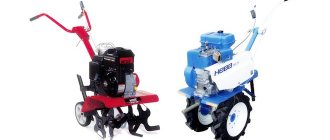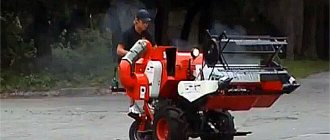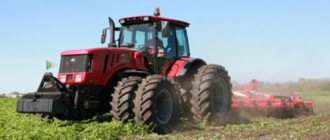Most owners of forestry equipment consider fuel consumption to be an important economic indicator that is taken into account when calculating costs. Specific fuel consumption - and therefore costs - can be reduced if the equipment is properly optimized and adapted to the specific operator's work style and local operating conditions.
A key prerequisite for this is the ability for the operator to use the full power of the equipment so that the machine is an obedient tool in his hands. This mode of operation of the equipment is the most effective, but you should not rush when choosing settings - to save fuel, the consistency of the functions is important.
Inconsistent features are “faster” but not “more efficient”.
Coordination of functions not only reduces fuel consumption, but will also increase productivity since the equipment will be simpler and easier to operate.
What functions do they have?
John Deere harvesters incorporate the latest technical advances with traditional quality and an increased desire to automate all processes.
The company's technologists pay special attention to the introduction of innovation, which allows the equipment of this manufacturer to keep up with the times.
Used for felling, bucking, delimbing, and assorting trunks for further transportation, harvesters of the mentioned brand are characterized by increased maneuverability, cross-country ability, high efficiency with minimized fuel costs.
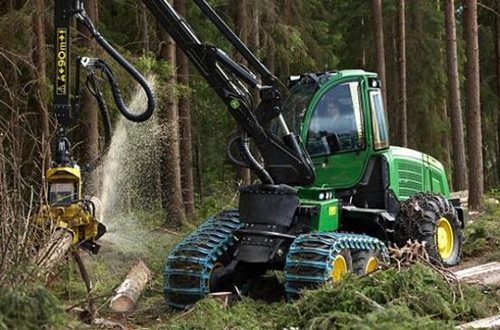
These machines are used both in forest plots and in road construction, performing well on soft soils, marshy soils and on smooth asphalt surfaces.
The manufacturer produces harvesters designed to perform the following actions:
- thinning and harvesting of small branches;
- clear felling of thin-trunked and larger trees;
- felling of forests of extreme difficulty.
The most in demand is technology focused on performing the processes indicated in the last two paragraphs.
Cat Harvester Design Benefits
Compared to conventional forestry equipment, harvesters have the following basic advantages:
- high performance. Depending on the model, it can be 150–300 m3 of wood per shift. In combination with a forwarder, the harvester is capable of harvesting more than 60,000 m3 of materials per year;
- quality of logging. Harvesters provide high-quality bucking of logs, allow you to accurately maintain the length and diameter of logs, which increases the efficiency of timber harvesting and reduces the amount of additional processing manipulations;
- accurate accounting of prepared materials. In this case, the human factor is completely eliminated, which helps prevent accidental or intentional errors. Accurate calculation makes it possible to effectively plan assortments by diameter and preliminarily determine the volumes obtained;
- automation of logging processes. This allows you to keep track of downtime and working time, fuel costs, determine productivity by area and time, and provides other useful capabilities for analytics;
- reducing the amount of waste. Provides the opportunity to obtain maximum returns from the logging process;
- the ability to carry out work in hard-to-reach areas and/or at night. This further improves harvesting productivity and efficiency;
- increasing the safety of logging operations. When using harvesters, there is no risk of injury to the feller from a chainsaw or a fallen tree;
- improving working conditions. The operator works in a comfortable, comfortable, ventilated, heated/cooled, insect-free, dust-free cab. Thus, the risk of occupational diseases among fellers is reduced;
- low cost. It is achieved by increasing the productivity of the logging process, reducing the number of personnel while maintaining or even increasing the volume of timber production.
- Reliable power transmission. Cat 521B and Cat 522B harvesters are equipped with patented Cat C9 ACERT engines that meet Tier 3 requirements. These drives provide excellent power, high torque, and comparatively low fuel costs. They are durable, extremely reliable, easy to maintain, and meet American standards in terms of environmental friendliness.
- Multifunctional hydraulics. Harvesters are equipped with closed-center hydraulic systems and electronic controls that can be programmed for specific tasks and operating conditions. The hydraulic system also includes separate pumps for the saw, working equipment, stroke and control circuits, which increases the convenience and stability of performing technological operations and setting the desired settings.
- Availability of leveling system (tilt). It is the only system that, when tilted, allows simultaneous movement in two directions along the entire stroke of the harvester. The Cat leveling system is equipped with three hydraulic cylinders and is characterized by high reliability and long service life.
- Versatile and reliable chassis. The machines are equipped with a new chassis of size D7. This solution ensures reliable operation during logging and allows work to be carried out on various terrain, including rocky slopes and swampy lowlands.
- Comfortable cabin. It is designed specifically for forestry equipment. The Cat harvester cab provides industry-leading operator comfort and protection for improved performance. The new ISO mounting system reduces vibration and acoustic effects. The controls have a thoughtful, ergonomic layout. The cabins have been tested to support 120% of the vehicle weight and meet OPS, ROPS, WCB, etc. standards.
- Durability. It is due to the reliable design of the harvesters and the fact that their production uses components and parts of increased strength, as well as the presence of protective elements. For example, the tracks are equipped with pads to prevent damage to the undercarriage. There are protective elements (grills, fences) and other important components, including the radiator, etc.
- Convenient controls. On Cat harvesters this is done using the IQAN electronic system. It allows you to set and configure many parameters, the data is displayed on a large monitor.
Additionally: High-quality hedge trimmer
Technical characteristics based on the example of the 1270 series
Launched in 1996 by the John Deer brand, the 1270 series of harvesters, produced for clear cutting, immediately gained worldwide recognition.
The technical solutions embodied in the models of this line were so successful that machines with article number 1270 still exist today, continuing to be constantly updated and improved.
Each of the modifications of the series represented a real revolutionary breakthrough in the development of technology in the category under consideration.
Harvesters of the 1270 series are divided into groups of machines of versions D and E. Forest harvesting units of this line have common features common to all versions and consist in the following parameters:
- six-wheel base;
- powerful 6-cylinder engine;
- rotating cabin;
- intelligent navigation system for controlling the sawing process and diagnosing the functioning of the main mechanisms and components.
In general, the technical characteristics of John Deere harvesters have only minor differences, and you can verify this by conducting a comparative analysis of some models of this manufacturer.
Also, such a consideration will help to delve in more detail into the root causes of the constructive perfection of the brand being described.
Version "E"
Harvesters of the 1270 E modification, launched into mass production in 2008, are machines that are significantly superior to the analogues of the previous D-series in terms of productivity, maneuverability and reliability.
Now felling large trunks and thinning old forests has become even more efficient.
Coinciding in the main structural units and elements with the previous technology, the new version of the equipment has a number of improved specifications, which can be presented in the following list:
- increase in engine power of the Tier IV standard to 170 kW;
- increase in torque , already reaching 1,125 Nm at 1,200-1,400 rpm;
- improvement of traction force indicators to parameters of 175 kNm;
- installation of a new CH7 manipulator with a 15% increased turning moment and 11% increased lift, a boom rotation angle of 220°, and a maximum extension of 8.6, 10 and 11.7 m;
- strengthening the supporting frames and, as a result, increasing the mobility of the cabin and improving the maneuverability of the entire machine as a whole.
The TimberMatic H-09 measurement and control system, which is equipped with all harvesters in the updated series, makes control even more convenient and simple.
Options for quick access to dialog boxes have been optimized, and a control function based on operating pressure indicators has appeared. The TimberLink™ program continues to distinguish these harvesters from a whole range of similar equipment.
Never before has it been so easy to monitor all operating processes occurring in equipment, detect defects and eliminate them. In addition to these options, TimberLink™ trains qualified operators to operate this equipment.
Types of harvesting combines
Modern harvesters have almost the same design and set of working components. However, they differ in appearance and certain parameters. Today, leading manufacturers use the classification of harvesters according to the following criteria.
By weight and diameter of the processed trunk:
- light – small-sized harvesters are used for cutting to thin out forested areas. Capable of felling trees with a diameter of 5–40 cm;
- medium – universal harvesters used for a wide range of forestry work, excellent at felling trees up to 50 cm thick;
- heavy - productive harvesters that are designed for large-scale logging operations. Easily cut down trees with a diameter of up to 60 cm;
- super-heavy – powerful and highly efficient equipment for complex work. Capable of cutting tree trunks more than 1 meter thick.
Additionally: Brush cutters attachment
By chassis type:
- wheeled harvester – has a powerful base with a 4 x 4, 6 x 6 or 8 x 8 wheel arrangement, complemented by all-wheel drive and special off-road tires;
- tracked harvester - has running wheels and track chains with tensioning mechanisms, often supplemented with snow chains.
By type of harvester head:
- combined type - have an articulated boom and a comfortable telescopic handle (the most common type);
- parallel type - have a lifting boom made in the form of a parallelogram and complemented by a telescopic handle.
What does the price depend on?
The cost of new models of the company in question, the 1270E series, starts from 22,650,000 rubles, while the same machine, which has accumulated engine hours in its arsenal, costs 12,000,000 rubles.
For used harvesters 1270 D and 1470 D (2006-2007 production) they will ask from 8,250,000 rubles, but new equipment of this type will cost from 17,000,000 rubles. The price range for equipment on the market is very wide.
The requested amounts depend not only on the technical condition of the machines and their operating time, year of production, but also on the pricing policy of the company carrying out the sale.
Harvester - operating principle and device
The harvester itself works as follows. The harvester approaches the trees in the area being processed and brings the working head close to the tree that it will fell. Then, with one cut, the tree is continuously cut down. But these manipulations can only be performed with small or medium-sized trees. But the harvester cuts down large trees differently. To begin with, the first cut is made, and then the head turns and another counter cut is made along the axis of the tree, thus also directing the tree in the desired direction, where the tree should fall. When a tree falls, the harvester head is disconnected from it, since a strong impact from a falling tree can damage the electronic system, which is responsible for measuring work.
After felling is completed, the trees are placed in a processing area where they are further processed. It happens as follows. A special pushing mechanism of the harvester pushes the trunk forward, where the tree trunk is processed using special loppers. All actions occur through the movement of the manipulator head along the tree trunk, so this process can be accelerated by increasing the speed of movement of the manipulator.

The operator is responsible for all actions, who in the cabin sets the desired pace of movement and the speed of the manipulator head. Modern harvesters are equipped with automatic measuring devices, with the help of which they perform not only all of the above operations, but also with the help of which it is possible to carry out work on cutting and bucking the material.
As a rule, modern harvesters are designed in such a way that processing one tree does not take more than one minute. Felling, of course, is somewhat slower, but what plays a role here is how spacious the working area is and how long it will take to bring the working head to the tree trunk. Harvesters have so firmly established their position in the logging industry that there can be no doubt about their usefulness. These machines are real workhorses that replace a lot of equipment and labor.
Characteristics of the Ponsse Fox harvester
Ponsse Fox harvesters are the optimal combination of basic solutions and the latest technologies. The minimum pressure on the ground exerted by these models of forestry machines allows the equipment to be operated on weak-bearing soils or on slopes.
Despite the fact that the H6 harvester head is intended primarily for selective cutting, it can be called universal equipment, which is also suitable for simultaneous processing of several trunks. The eight-wheeled harvester model has a low center of gravity and excellent stability. The weight of the equipment is 18.2 tons.
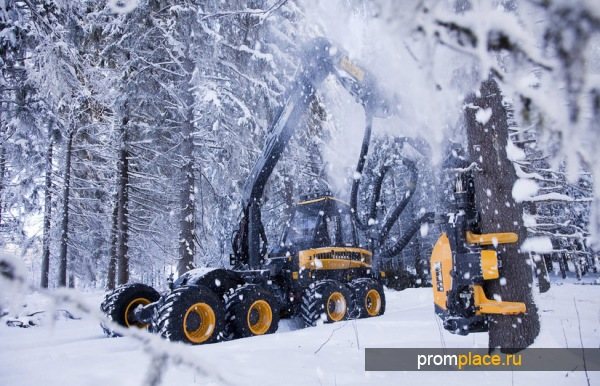
The harvester is equipped with a C22 crane with a rotation angle of 250°, a tilt angle of 30° and a lifting torque of 205 kNm. The boom radius is 11 m (with H5 harvester head) and 10.3 m (with H6 head). Engine power – 197 hp.
Ponsse Scorpion harvester - model review
So, the Ponsse Scorpion harvester is an eight-wheeled vehicle equipped with a unique crane. Excellent visibility in all directions allows the operator to carry out his work without unnecessary interference, quickly selecting trees and the direction of their felling. Working on rough terrain also does not cause inconvenience - the cabin located in the central part of the machine does not lose its balance. Excellent stability of this harvester is ensured thanks to 8 wheels and an active stabilization system.
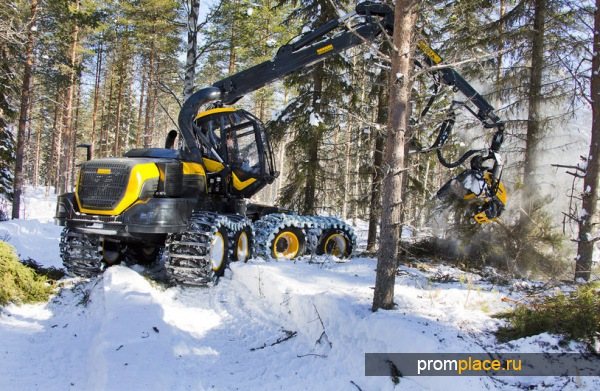
The weight of this Ponsse harvester is 21.5 tons, length is 8 m, height is 3.7 m. The width of the equipment varies from 2.64 to 2.84 m. The installed C50 manipulator has a boom reach of 10.3 / 11 m and a lifting moment – 252 kNm. The angle of rotation of the crane is 280°. The harvester is equipped with a Mercedes-Benz engine with a power of 286 hp. and the Ponsse OptiControl hydraulic control system. Harvester heads – H5, H6, H7 with a lifting capacity of 950 / 1050 / 1200 kg, respectively.
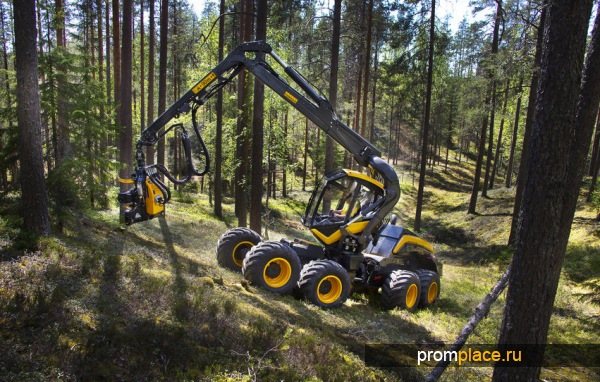
How to choose the right harvester
When choosing a harvester, different criteria are taken into account than when choosing a car. Here it is much more important to pay attention to:
- engine power
- ability to work in difficult areas
- performance
- cabin equipment
- convenient conditions for the operator
- harvester cost
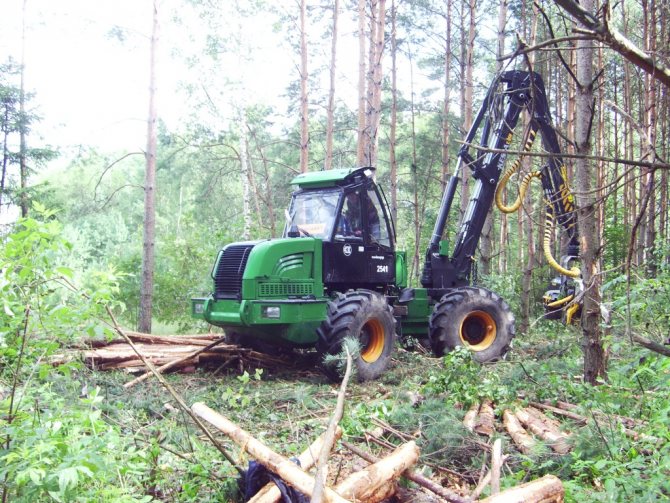
In the modern world, when most of the work is performed by machines, special attention should be paid to the parameters on which the cross-country ability and nominal performance of the units depend. Harvester Amkodor 2551 is used for felling, bucking trees into pieces of a given length and trimming branches. Its 6x6 wheel arrangement is distinguished by an increased level of cross-country ability and maneuverability. The machine was designed taking into account modern standards of quality and operational safety.
- Manipulator
A creeping manipulator from Kesla (Finland) is mounted on the harvester. Its rotation angle is 260 degrees, and the maximum ejection of the manipulator boom is 9.5 meters.
- Fastening
It is movable and allows you to interact with a tilt angle of 15 degrees.
- Engine
Model D-260.9, has 6 cylinders, is diesel. Gross power is 180 hp. A built-in intercooler is a radiator, which is an air cooling system. Equipped with turbines.
- Technical components and special units
To increase reliability and performance, the harvester is equipped with modern spare parts. The rear balancer axle on the car is made by the German manufacturer NAF.
- Transmission
The transmission of the device, even at low engine speeds, can provide a smooth ride, without characteristic jerks.
- Lighting
To improve performance and optimize operation, 14 headlights are installed on the harvester. 10 of them are on the roof of the driver's cab, and the rest are on the creeping manipulator.
- Preheater
In order to quickly start the car at subzero temperatures, an autonomous pre-heater from the German manufacturer EBERSPEHER is used.
- Improved maneuverability
To increase maneuverability when moving through wetlands or snow cover, snow chains or tracks are used.

Before choosing a harvester, it is necessary to assess the conditions at the logging site. If the plots are located far from each other and the distance between them is quite large, a wheeled harvester will be the best option. Because tracked harvesters are best used on flat terrain. The performance of wheeled and tracked harvesters is almost identical. However, the most important issue is always the issue of savings. If your production is just beginning to develop, expensive imported equipment with similar characteristics will not be suitable. Pay attention to the Belarusian company Amkodor, which has been impressing specialists around the world for several years now.
